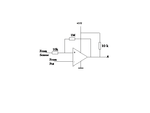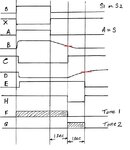Kolero
Member level 1
- Joined
- Dec 10, 2010
- Messages
- 41
- Helped
- 0
- Reputation
- 0
- Reaction score
- 0
- Trophy points
- 1,286
- Location
- Vancouver, BC
- Activity points
- 1,795
You're a genius! I tried a 100 uF capacitor between the +5 and 0 volt lines and I was still getting some minor modulation, so I tried a 470 uF and it works great.
With IC1 put back in place, the sensor works as expected.
If I put the 10k pull up resistor between the IC1 output and +5v, I get the motorboating sound. Without the resistor, no motorboating and no ill effect.
I just did some voltage tests on the circuit, measuring between Ground and A.
Without the resistor and no object in front of the sensor, I get 0.05 volts.
With an object in front of the sensor, I get 3 volts.
Everything sounds normal.
With the 10k resistor in place, I still get 0.05 volts with no object in front of the sensor and a motor boating sound. But when I place my multimeter probe at A to check the voltage, the motor boat sound stops.
Place an object in front of the sensor and I get 5 volts, crisp and clear.
Remove the object, with the multimeter probe in place, Tone G sounds funny, like it's oscillating between two notes, but stops after a second and it's silent.
Remove the probe and it's back to motorboating.
Do I *need* the pull up resistor if it appears to be working without it?
With IC1 put back in place, the sensor works as expected.
If I put the 10k pull up resistor between the IC1 output and +5v, I get the motorboating sound. Without the resistor, no motorboating and no ill effect.
I just did some voltage tests on the circuit, measuring between Ground and A.
Without the resistor and no object in front of the sensor, I get 0.05 volts.
With an object in front of the sensor, I get 3 volts.
Everything sounds normal.
With the 10k resistor in place, I still get 0.05 volts with no object in front of the sensor and a motor boating sound. But when I place my multimeter probe at A to check the voltage, the motor boat sound stops.
Place an object in front of the sensor and I get 5 volts, crisp and clear.
Remove the object, with the multimeter probe in place, Tone G sounds funny, like it's oscillating between two notes, but stops after a second and it's silent.
Remove the probe and it's back to motorboating.
Do I *need* the pull up resistor if it appears to be working without it?






